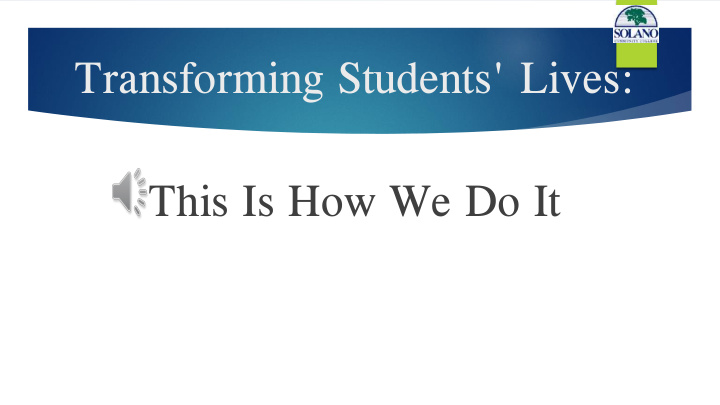



Transforming Students' Lives: This Is How We Do It
Accreditation: What is it? Peer review teams visit colleges and universities to: certify standards are being met recommend improvements commend excellent practices ACCJC, the Accrediting Commission for Community and Junior Colleges Accreditation visit: October, 2017
Why is accreditation important? Resources, programs and services support student learning and student achievement Academic quality and continuous improvement Ongoing assessment is taking place toward improvement Academic excellence through ongoing, integrated planning and evaluation
What are the four standards in accreditation? Standard I: Mission, Academic Quality and Institutional Effectiveness, and Integrity College mission, assuring quality and institutional effectiveness, and institutional integrity in performing our duties. Standard II: Student Learning Programs and Support Services Everything related to instruction, library, and student services. Standard III: Resources Human resources, physical resources, technology resources, and financial resources. Standard IV: Leadership and Governance Decision-making roles and processes, the chief executive officer, and the governing board.
More Accreditation Information www.ACCJC.org For a brief online course (one-two hours) on accreditation basics, go to www.trainingway.com/accjc/ Flex credit eligible!
Timeline for Solano’s Self -Evaluation Nov. 2015- Feb. 2016: Standards Chairs and teams selected Evidence collection protocols developed, teams trained Spring-summer 2016: Evidence collection
Timeline for Solano’s Self-Evaluation cntd. Fall 2016: Evidence collection continues Weekly meetings between Lead Writer and Standards Chairs Draft report: target completion of first draft by Jan. 2017
Timeline for Solano’s Self -Evaluation cntd. Spring 2017: Vet drafts with all constituent groups Continue to add / update evidence to reflect changing / emerging practices Revise, revise, revise Ready for final Board approval and publication by mid-June 2017
What is “evidence”? Artifacts of our day-to-day work that show how we: Serve students Develop initiatives Communicate internally and externally Collect and use data Make decisions Improve our practices on all fronts: Course, program, and degree offerings Instruction & Student services Use of resources
Evidence Example: Standard II.A Standard II.A.3 The institution identifies and regularly assesses learning outcomes for courses, programs, certificates and degrees using established institutional procedures. Standard II.A.16 The institution regularly evaluates and improves the quality and currency of all instructional programs offered in the name of the institution... The institution systematically strives to improve programs and courses to enhance learning outcomes and achievement for students.
Evidence Example: Standard II.A.3 & 16 Evidence: Data-driven modification to Human Services 54 course In February of 2015, a prerequisite of HS 51 to HS 54 was approved based on R&P data that supported classroom experience. Reviewing data provided in Table 1 (over the past 4 years), we find that when students first take HS 51 Introduction to Human Services before HS 54 Group Process, they earn: 18.15% more As 6.4 % more Bs 9.56% fewer Cs 6.64% fewer Fs 9.34% fewer Ws
Evidence Example: Standard II.A.3 & 16
This is How we Do it: Collecting Evidence Teams Expertise & Experience Infrastructure Canvas
This is How WE Do it Today Complete Handouts Participate: Break-Out Session today 1-2pm, Bldg. 400, Rm. 446 Stay Informed: Fun Facts Contact Team Administrators and Leaders
Accreditation at Solano College Standard I: Mission, Academic Quality and Institutional Effectiveness, and Integrity Standard II: Student Learning Programs and Support Services Standard III: Resources Standard IV: Leadership and Governance
Recommend
More recommend